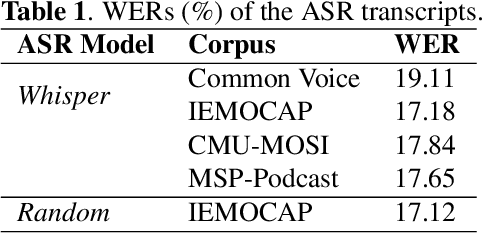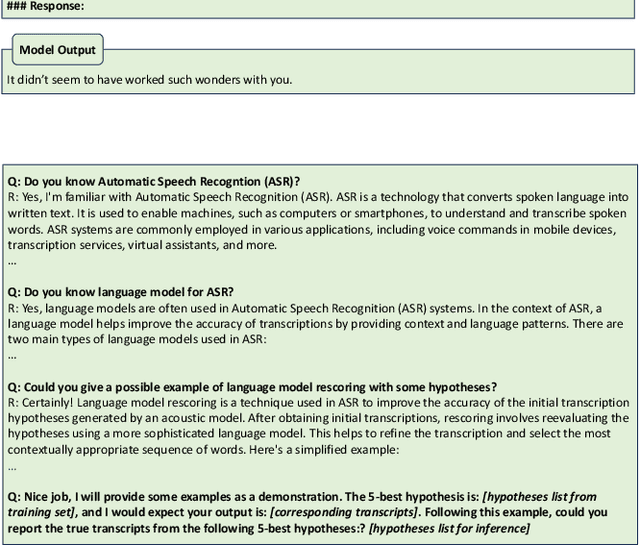Pinzhen Chen
CHARM: Calibrating Reward Models With Chatbot Arena Scores
Apr 14, 2025Abstract:Reward models (RMs) play a crucial role in Reinforcement Learning from Human Feedback by serving as proxies for human preferences in aligning large language models. In this paper, we identify a model preference bias in RMs, where they systematically assign disproportionately high scores to responses from certain policy models. This bias distorts ranking evaluations and leads to unfair judgments. To address this issue, we propose a calibration method named CHatbot Arena calibrated Reward Modeling (CHARM) that leverages Elo scores from the Chatbot Arena leaderboard to mitigate RM overvaluation. We also introduce a Mismatch Degree metric to measure this preference bias. Our approach is computationally efficient, requiring only a small preference dataset for continued training of the RM. We conduct extensive experiments on reward model benchmarks and human preference alignment. Results demonstrate that our calibrated RMs (1) achieve improved evaluation accuracy on RM-Bench and the Chat-Hard domain of RewardBench, and (2) exhibit a stronger correlation with human preferences by producing scores more closely aligned with Elo rankings. By mitigating model preference bias, our method provides a generalizable and efficient solution for building fairer and more reliable reward models.
XL-Instruct: Synthetic Data for Cross-Lingual Open-Ended Generation
Mar 29, 2025Abstract:Cross-lingual open-ended generation -- i.e. generating responses in a desired language different from that of the user's query -- is an important yet understudied problem. We introduce XL-AlpacaEval, a new benchmark for evaluating cross-lingual generation capabilities in Large Language Models (LLMs), and propose XL-Instruct, a high-quality synthetic data generation method. Fine-tuning with just 8K XL-Instruct-generated instructions significantly improves model performance, increasing the win rate against GPT-4o-Mini from 7.4% to 21.5%, and improving on several fine-grained quality metrics. Additionally, models fine-tuned on XL-Instruct exhibit strong zero-shot transfer to both English-only and multilingual generation tasks. Given its consistent gains across the board, we strongly recommend incorporating XL-Instruct in the post-training pipeline of future multilingual LLMs. To facilitate further research, we will publicly and freely release the XL-Instruct and XL-AlpacaEval datasets, which constitute two of the few cross-lingual resources currently available in the literature.
Generalizing From Short to Long: Effective Data Synthesis for Long-Context Instruction Tuning
Feb 21, 2025Abstract:Long-context modelling for large language models (LLMs) has been a key area of recent research because many real world use cases require reasoning over longer inputs such as documents. The focus of research into modelling long context has been on how to model position and there has been little investigation into other important aspects of language modelling such as instruction tuning. Long context training examples are challenging and expensive to create and use. In this paper, we investigate how to design instruction data for the post-training phase of a long context pre-trained model: how much and what type of context is needed for optimal and efficient post-training. Our controlled study reveals that models instruction-tuned on short contexts can effectively generalize to longer ones, while also identifying other critical factors such as instruction difficulty and context composition. Based on these findings, we propose context synthesis, a novel data synthesis framework that leverages off-the-shelf LLMs to generate extended background contexts for high-quality instruction-answer pairs. Experiment results on the document-level benchmark (LongBench) demonstrate that our proposed approach outperforms previous instruction synthesis approaches and comes close to the performance of human-annotated long-context instruction data. The project will be available at: https://github.com/NJUNLP/context-synthesis.
Context and System Fusion in Post-ASR Emotion Recognition with Large Language Models
Oct 04, 2024Abstract:Large language models (LLMs) have started to play a vital role in modelling speech and text. To explore the best use of context and multiple systems' outputs for post-ASR speech emotion prediction, we study LLM prompting on a recent task named GenSEC. Our techniques include ASR transcript ranking, variable conversation context, and system output fusion. We show that the conversation context has diminishing returns and the metric used to select the transcript for prediction is crucial. Finally, our best submission surpasses the provided baseline by 20% in absolute accuracy.
EMMA-500: Enhancing Massively Multilingual Adaptation of Large Language Models
Sep 26, 2024



Abstract:In this work, we introduce EMMA-500, a large-scale multilingual language model continue-trained on texts across 546 languages designed for enhanced multilingual performance, focusing on improving language coverage for low-resource languages. To facilitate continual pre-training, we compile the MaLA corpus, a comprehensive multilingual dataset enriched with curated datasets across diverse domains. Leveraging this corpus, we conduct extensive continual pre-training of the Llama 2 7B model, resulting in EMMA-500, which demonstrates robust performance across a wide collection of benchmarks, including a comprehensive set of multilingual tasks and PolyWrite, an open-ended generation benchmark developed in this study. Our results highlight the effectiveness of continual pre-training in expanding large language models' language capacity, particularly for underrepresented languages, demonstrating significant gains in cross-lingual transfer, task generalization, and language adaptability.
Pitfalls and Outlooks in Using COMET
Sep 02, 2024



Abstract:Since its introduction, the COMET metric has blazed a trail in the machine translation community, given its strong correlation with human judgements of translation quality. Its success stems from being a modified pre-trained multilingual model finetuned for quality assessment. However, it being a machine learning model also gives rise to a new set of pitfalls that may not be widely known. We investigate these unexpected behaviours from three aspects: 1) technical: obsolete software versions and compute precision; 2) data: empty content, language mismatch, and translationese at test time as well as distribution and domain biases in training; 3) usage and reporting: multi-reference support and model referencing in the literature. All of these problems imply that COMET scores is not comparable between papers or even technical setups and we put forward our perspective on fixing each issue. Furthermore, we release the SacreCOMET package that can generate a signature for the software and model configuration as well as an appropriate citation. The goal of this work is to help the community make more sound use of the COMET metric.
Quality or Quantity? On Data Scale and Diversity in Adapting Large Language Models for Low-Resource Translation
Aug 23, 2024Abstract:Despite the recent popularity of Large Language Models (LLMs) in Machine Translation (MT), their performance in low-resource translation still lags significantly behind Neural Machine Translation (NMT) models. In this paper, we explore what it would take to adapt LLMs for low-resource settings. In particular, we re-examine the role of two factors: a) the importance and application of parallel data, and b) diversity in Supervised Fine-Tuning (SFT). Recently, parallel data has been shown to be less important for MT using LLMs than in previous MT research. Similarly, diversity during SFT has been shown to promote significant transfer in LLMs across languages and tasks. However, for low-resource LLM-MT, we show that the opposite is true for both of these considerations: a) parallel data is critical during both pretraining and SFT, and b) diversity tends to cause interference, not transfer. Our experiments, conducted with 3 LLMs across 2 low-resourced language groups - indigenous American and North-East Indian - reveal consistent patterns in both cases, underscoring the generalizability of our findings. We believe these insights will be valuable for scaling to massively multilingual LLM-MT models that can effectively serve lower-resource languages.
Is It Good Data for Multilingual Instruction Tuning or Just Bad Multilingual Evaluation for Large Language Models?
Jun 18, 2024



Abstract:Large language models, particularly multilingual ones, are designed, claimed, and expected to cater to native speakers of varied languages. We hypothesise that the current practices of fine-tuning and evaluating these models may mismatch this intention owing to a heavy reliance on translation, which can introduce translation artefacts and defects. It remains unknown whether the nature of the instruction data has an impact on the model output; on the other hand, it remains questionable whether translated test sets can capture such nuances. Due to the often coupled practices of using translated data in both stages, such imperfections could have been overlooked. This work investigates these issues by using controlled native or translated data during instruction tuning and evaluation stages and observing model results. Experiments on eight base models and eight different benchmarks reveal that native or generation benchmarks display a notable difference between native and translated instruction data especially when model performance is high, whereas other types of test sets cannot. Finally, we demonstrate that regularization is beneficial to bridging this gap on structured but not generative tasks.
Crossmodal ASR Error Correction with Discrete Speech Units
May 26, 2024



Abstract:ASR remains unsatisfactory in scenarios where the speaking style diverges from that used to train ASR systems, resulting in erroneous transcripts. To address this, ASR Error Correction (AEC), a post-ASR processing approach, is required. In this work, we tackle an understudied issue: the Low-Resource Out-of-Domain (LROOD) problem, by investigating crossmodal AEC on very limited downstream data with 1-best hypothesis transcription. We explore pre-training and fine-tuning strategies and uncover an ASR domain discrepancy phenomenon, shedding light on appropriate training schemes for LROOD data. Moreover, we propose the incorporation of discrete speech units to align with and enhance the word embeddings for improving AEC quality. Results from multiple corpora and several evaluation metrics demonstrate the feasibility and efficacy of our proposed AEC approach on LROOD data, as well as its generalizability and superiority on large-scale data. Finally, a study on speech emotion recognition confirms that our model produces ASR error-robust transcripts suitable for downstream applications.
Fine-Tuning Large Language Models to Translate: Will a Touch of Noisy Data in Misaligned Languages Suffice?
Apr 22, 2024



Abstract:Traditionally, success in multilingual machine translation can be attributed to three key factors in training data: large volume, diverse translation directions, and high quality. In the current practice of fine-tuning large language models (LLMs) for translation, we revisit the importance of all these factors. We find that LLMs display strong translation capability after being fine-tuned on as few as 32 training instances, and that fine-tuning on a single translation direction effectively enables LLMs to translate in multiple directions. However, the choice of direction is critical: fine-tuning LLMs with English on the target side can lead to task misinterpretation, which hinders translations into non-English languages. A similar problem arises when noise is introduced into the target side of parallel data, especially when the target language is well-represented in the LLM's pre-training. In contrast, noise in an under-represented language has a less pronounced effect. Our findings suggest that attaining successful alignment hinges on teaching the model to maintain a "superficial" focus, thereby avoiding the learning of erroneous biases beyond translation.
 Add to Chrome
Add to Chrome Add to Firefox
Add to Firefox Add to Edge
Add to Edge